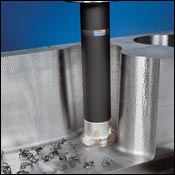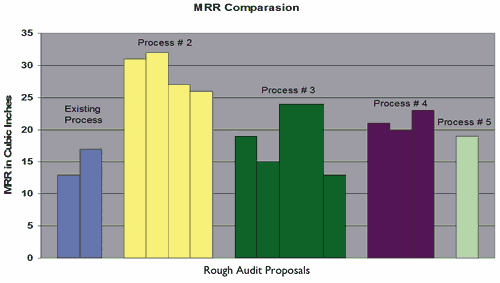Measure Your Success for Rough Milling Improvements
In moldmaking, most applications still follow the traditional two- or three-phase process consisting of rough/pre-finish/finish, in order to hold tolerances. The following article will focus on the first phase of operations—the roughing phase—and how shops can improve rough milling applications with new strategies and cutting tools.
Moldmaking is a globally competitive market. With that said, how do you think your company competes when measured against the best moldmakers in the world? The first step to an improvement can be as simple as asking, “Is there something better”?
When it comes to cutting tools for roughing applications, if you haven’t asked yourself the previous question for a few years, it’s time to find out about new technology. Do you know your current rough milling capabilities (in terms of metal removal)? Once you truly know the capabilities of your current cutting tools and machining methods, you can seek out new technologies and compare your shop against them at any time.
Define, Measure and Choose
How do you measure and then choose a process/solution? Today’s large manufacturing companies are using programs like 6σ (Six Sigma) and lean manufacturing to help them make decisions. And what about the average mold shop, how do they make decisions? Most companies rely on a few people to make the majority of decisions and they do so based on experience and gut instinct. This approach leaves much to be desired, adding bias and a host of other negative variables to a problem.
The nice thing about a program like 6σ is that—through using the programs tools—a person measures and validates an approach with information derived from data. We are not suggesting that the average tool and die company has to implement a comprehensive program like 6σ to help them make decisions, but it is suggested that some of the basic principles of these programs (like define and measure) would help take the guesswork out of whether or not a decision will benefit the bottom line and whether a project should be launched.
This can help technical people make a business case to the owner before a decision to move forward is made by outlining the goals and benefits of the project.
Measuring: Metal Removal Rate (MRR)
The basic calculation for metal removal is feedrate (minute), multiplied by width-of-cut, multiplied by depth-of-cut (fm×w×d). There are variables that will affect the accuracy of this calculation: part geometry, machine tool, programming and cutting tool.
A simple and effective way to ensure accurate calculations when measuring metal removal rates is to divide the volume of material being removed by the total time of machining (volume/time = MRR). Try it. You’ll see that in many situations, especially high-feed milling, there can be major differences between programmed and actual metal removal rates.
Also, this is usually the best/easiest way to measure the metal removal rate for plunge milling due to the complexity of calculating for the various engagement options that can be used.
Now let’s assume you have determined an area that your shop wants/needs to make improvements; you have defined a project. Now you need to seek out and measure solutions for possible improvements.
If working with more than one company, chances are you’re noticing trends and similar challenges. The similarities are good because data groupings would indicate that a proposed solution/approach for improvement is likely. This also raises red flags for proposals that are off the charts. You might discard this proposal, or request more data/proof for a proposal that seems unrealistic.
In Graph 1 you can see that the suppliers involved with Process #2 proposals, all believe they can/would make a significant improvement over the existing process.
Measuring Success
In business, success is measured by earnings (i.e., profit). When seeking to improve cutting tools, the measure should not be different. Many companies choose to focus on the price of an item, while failing to recognize the total spent (overall costs) would be greater.
How do you measure the value of a cutting tool? The variables affecting the answer to this will be unique for each moldmaking company and each project, but the variables should not change when testing (control), if you want true comparisons of which tool/process best fits your needs.
For roughing tools, the most common form of measurement is usually metal removal rate (MRR), and the cost per cubic inch (or cubic centimeter) of metal removal. In the end, the success is measured by a unit cost.
Don’t stop a project due to a question of price. In Graph 2, a $100.00 roughing burdened rate is assumed with proposed tooling prices listed. Notice that the tool with the highest cost per insert ended up being the most cost-effective solution when time cost (burden rate × time) and tool cost to machine 1000 in³ of material were considered.
Rough Milling Applications: Technology and Tips
Plunge Milling
Plunge milling has been around for a long time and can be the most consistent form of high metal removal, especially on older machines incapable of operating at high feedrates. This consistency is a result of efficient toolpaths, as there is little wasted tool motion when compared to more common methods of machining when part geometry forces the cutter into many directional changes (e.g., Z level).
Center cutting plungers exist, but the most recent advancements come in the form of side plungers. Programming solutions to support plunge milling is an area of recent improvements for many CAD/CAM companies, and good solutions exist for plunge milling of 3-D geometries, as well as 2-D.
On the product side, advanced pressing technologies have allowed the creation of inserts with more positive geometry, which reduces cutting and bending forces and allows plunging to be performed (for the most part) without the need for angular retracts. This saves time and intensive programming, allowing operators to use canned drilling cycles for plunging. Tangential designs provide increased strength with an insert having four edges for enhanced cost benefit.
Shred Milling
Anti-vibration milling cutters (see Figure 1) are a solution provider when vibrations and unfavorable conditions are encountered (long reach, unstable fixture, chip removal issues, machine power limitations). This technology is also nothing new, but it is an area that has been improved upon with positioning accuracy of the insert (to avoid feed overload from one tooth to the next) and a variety of insert (pressed and ground) geometries enabling the user to customize the tool to the application/material at hand. Usually, when faced with poor cutting conditions, the parameters are reduced to enable the completion of the part.
Other costly solutions include purchasing vibration dampening toolholders and coarse pitch cutters. With anti-vibration milling cutters, the wave design of the cutting edge creates small serrated chips, which are lighter and easier to evacuate from the cutting zone. The design also reduces cutting forces and breaks up harmonics (vibrations) that are common, especially in long reach applications.
High-Feed Milling
High-feed milling is the most universal approach to increased metal removal rates in roughing. High-feed type cutters have also been around now for quite some time, although many companies still have not experimented with the approach. For moldmaking, the high-feed approach in 3-D applications works very well because the small depth-of-cut characteristics leave small scallop heights (leftover material) for subsequent operations while maintaining a very high metal removal rate.
There has been a huge demand for cutting tools with high-feed geometry and this has led to the development of a wide range of tools, from solid carbide tools in smaller diameters (1/8" to 5/16") to the indexable tools ranging from 5/16" all the way up to 6” in diameter. This is also an area where advancements in pressing technology has enabled the creation of double-sided inserts that reduce cutting forces, while offering twice the number of cutting edges for enhanced cost savings (six edges per insert).
Summary
Part geometry, machine tool, programming and cutting tool are the major variables that each moldmaker deals with daily and which play a factor in the approach that each company takes when processing a mold. Regarding cutting tools for roughing, the approach and tool you choose may be unique for each job.
They say that investments in technology help companies stay ahead of the competition. But, unless you invented it, that technology is available to everyone. And, what if your investment is in something that has been available for years that the guy down the street is already using? Now you’re just catching up. Technology is one of the means through which continuous improvements are made, and at the very least you’re competitive in the market. When it comes to productivity gains in roughing applications, cutting tool technology can play a major role, but at what cost? Start measuring and you’ll know.
Acknowledgment
The author would like to thank Noel Pinto, Manufacturing Engineer, Husky Injection Molding for his contribution to this article.
Related Content
Machining Center Spindles: What You Need to Know
Why and how to research spindle technology before purchasing a machining center.
Read MoreLaser Welding Versus Micro Welding
The latest battle in finely detailed restoration/repair of mold materials.
Read MoreMoldmakers Deserve a Total Production Solution
Stability, spindle speed and software are essential consideration for your moldmaking machine tool.
Read MoreRevisiting Some Hot Runner Fundamentals
What exactly does a hot runner do? If you’ve been in the injection molding industry for any length of time, you might think the answer is obvious, but it is not.
Read MoreRead Next
Use Plunging to Increase Metal Removal Rates
Recent cutting tool innovation—as well as new CAM programming techniques—make plunging a more popular approach.
Read MoreReasons to Use Fiber Lasers for Mold Cleaning
Fiber lasers offer a simplicity, speed, control and portability, minimizing mold cleaning risks.
Read MoreHow to Use Continuing Education to Remain Competitive in Moldmaking
Continued training helps moldmakers make tooling decisions and properly use the latest cutting tool to efficiently machine high-quality molds.
Read More
























